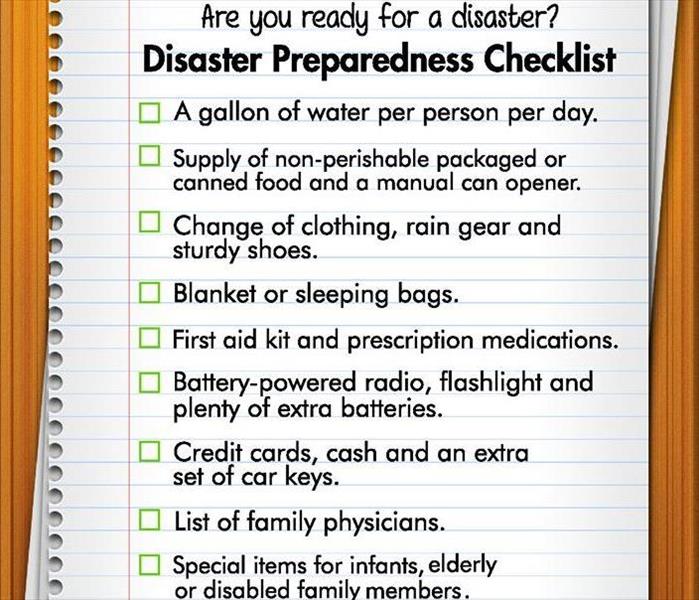Clear Lake Home Health: The Definitive Summer Storm Checklist for the Greater Houston Area
6/2/2016 (Permalink)
SERVPRO of Clear Lake wants to remind our community that we are heading into severe weather season. It is imperative to prepare for the worst-case scenario, because a slow-moving thunderstorm, hurricane, or other event can cause significant water damage in the greater Houston area, making it difficult to evacuate or even get around. As we have witnessed over the last few years, flood damages our local businesses, homes, roads, and the infrastructure we depend upon. Use this checklist in the event a natural disaster is forecast for Clear Lake and surrounding areas:
Now:
1. Develop and Test an Evacuation Plan. Make sure every family member knows the evacuation plan and an alternate route in the event roads are blocked.
2. Inventory your Home. Take photos and videos, and complete an inventory of all items in your home, garage, attic, and any storage sheds. Back up this information offsite.
3. Develop and Test Your Communication Plan. Plan and test two scenarios, the first for a storm or event forecast in advance, and the second for an emergency situation with no warning. Include family and friends outside the zone.
4. Make Plans for Pets. Where will pets stay and how will they be transported in the event you must evacuate? Make sure they are up to date on all shots, are micro-chipped, and that you have piddle pads or newspapers on hand in the event they need to relieve themselves during a vicious storm.
5. Purchase a First Aid Kit. Make sure to include elastic bandages, scissors, tape, antibacterial creams, and general wound care items.
6. List Items for a “Go Bag.” Each family member and pet should have a dedicated bag that can be quickly filled with necessary items in the event you must evacuate immediately. Include clothing for severe weather and its aftermath, including boots, eye protection, gloves, long pants, long-sleeved shirts, undergarments, sleeping attire, and items for personal hygiene.
7. Clean Up Landscaping. Trim any low tree branches, as well as branches that could go through a window or damage the roof. Remove debris from gutters and make sure gutters have extenders to drain excess water away from home.
8. Schedule a Roof Inspection. It is wise to schedule an annual roof inspection prior to storm season each year to prevent leaks and damage to your home.
9. Check Window Well Covers for Cracks.
10. Test Sump Pump, Backup Battery, and Hose.
11. Store Important Documents in Watertight Containers. These include passports, birth certificates, marriage/divorce decrees, and other documents as necessary. Preferably, scan and keep all items in offsite or Cloud storage.
When Storm is 2-3 Days Out:
1. Purchase Plywood for Windows and Doors.
2. Backup Computer, Phone, and Tablets.
3. Fill all Vehicles with Fuel.
4. Purchase Ample Water. A good rule of thumb is one gallon per day, per person in the home. Don’t forget that pets will also need water.
5. Store 3-5 Days’ Worth of Non-Perishable Food.
6. Stage Flashlights Throughout the Home and Test Batteries. Purchase headlamps for greater security and hands-free operation. Many have a flashing red light setting for emergencies.
7. Test Battery-Powered Radio.
8. Pack “Go Bags.” Add clothing, medications, important papers, and your evacuation and communication plans.
9. Turn Refrigerator and Freezer to Coldest Setting. In the event power is shuttered, this will give your food more time at safe temperatures. You can freeze a gallon or two of milk, and once power is off, keep items cool in the refrigerator.
10. Listen to Local News Outlets. Heed storm warnings. Pay particular attention to the location of shelters in your area.
When Storm is 24 Hours Out:
1. Close Shutters or Board up Windows with 5/8 inch Plywood and Reinforce Garage Door. This can help prevent water and other storm damage to your home.
2. Bring all Outdoor Items Inside. This includes patio furniture, BBQ grills, and other items that could become projectiles in the event of high winds.
3. Fill Bathtub with Water. This water can be used for personal grooming, flushing the toilet, etc. Water may not be drinkable after a significant weather event.
4. Charge All Devices.
5. Gather Board Games and Coloring Books for Kids. Set up a play area in an interior room with items to keep them occupied during the storm.
During the Storm:
1. Unplug Electronics.
2. Stay Inside.
3. Follow Local News and Heed All Warnings.
4. Wear Whistles Around the Neck. In the event you need to evacuate or your home becomes damaged, each person should be wearing a whistle.
5. Evacuate if Recommended Via Your Evacuation Plan, or as per First Responder Instructions.
When the storm has passed, remember that flooding is still a possibility for some of the lower lying areas of our community. Never drive or walk through flooded areas, as floodwaters are extremely powerful and can carry potentially hazardous wildlife and debris. If your Clear Lake or surrounding area home is damaged, call Clear Lake SERVPRO immediately. We can work directly with your insurance company to fix the damage caused by seasonal storms.

 24/7 Emergency Service
24/7 Emergency Service
